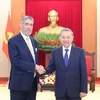President Truong Tan Sang on December 8 signed an order to promulgate the Constitution of the Socialist Republic of Vietnam and a resolution stipulating the implementation of the Constitution.
The Constitution, which was revised on the basis of the 1992 document, was adopted at the freshly-ended sixth session of the 13 th National Assembly with nearly 98 percent of votes.
The 13th NA, in its first session, issued a resolution on amending and supplementing the 1992 Constitution and establishing the Committee for Drafting Amendments to the 1992 Constitution.
Feedback on the draft was gathered from agencies, organisations and individuals, including overseas Vietnamese. Based on their opinions, the National Assembly considered the draft during three sessions (fourth to sixth).
The revised Constitution is divided into 11 chapters with 120 articles (one chapter and 27 articles fewer than the previous version). Repeated content has been cut while unclear articles have been clarified.
The structure of the updated Constitution has been made clearer, especially the articles on human rights and the rights and obligations of citizens.
The new document clearly states that the Socialist Republic of Vietnam is governed by law and mastered by the people.
It also elucidates the position of the Communist Party of Vietnam ( CPV ) as the vanguard of the nation. For the first time, the Constitution clarifies the responsibility that the CPV bears as a ruling party. With this content, the Party’s leadership and the role of Party members have been further enhanced.
The amended Constitution manifests the ownership of the people who exercise their power either directly or through the National Assembly, the People’s Council and other representative agencies.
Meanwhile, the document also clearly specifies human rights and supplements previous content related to the rights of citizens – the outcomes of the country’s human development efforts during nearly 30 years of renewal.
Regarding socio-economy, the amended Constitution merges two chapters on economy and socio-culture, science, education and technology into one chapter, highlighting the close connection among the issues, showing the nature of Vietnam ’s economy as a market-based one following the socialist orientations.
The document does not list all the economic sectors, but still confirms the key role of the State-owned sector.
Regulations on land issues are also one of the new features of the amended Constitution. The document said land comes under ownership by the entire people, while making clearer land retrieval regulations.
On the State apparatus, the document basically inherits the State organisation model mentioned in the old version, but better explains the principle that State powers are unified and decentralised to State bodies in the exercise of their legislative, executive and judiciary powers.
The revised Constitution also regulates the organisation of the court system, with the people’s procuracy playing the role as a constitutional basis for judiciary reform.
The document regulates administrative territorial units, while adding important contents on exclusive administrative economic units. It underscores the necessity to collect local residents’ opinions on the merging and dividing of administrative territorial units in accordance to the law.
Other new content includes detail about the dependent institutions of the National Election Council and the State Audit. Also, for the first time Vietnamese has been confirmed as the national language.-VNA



















